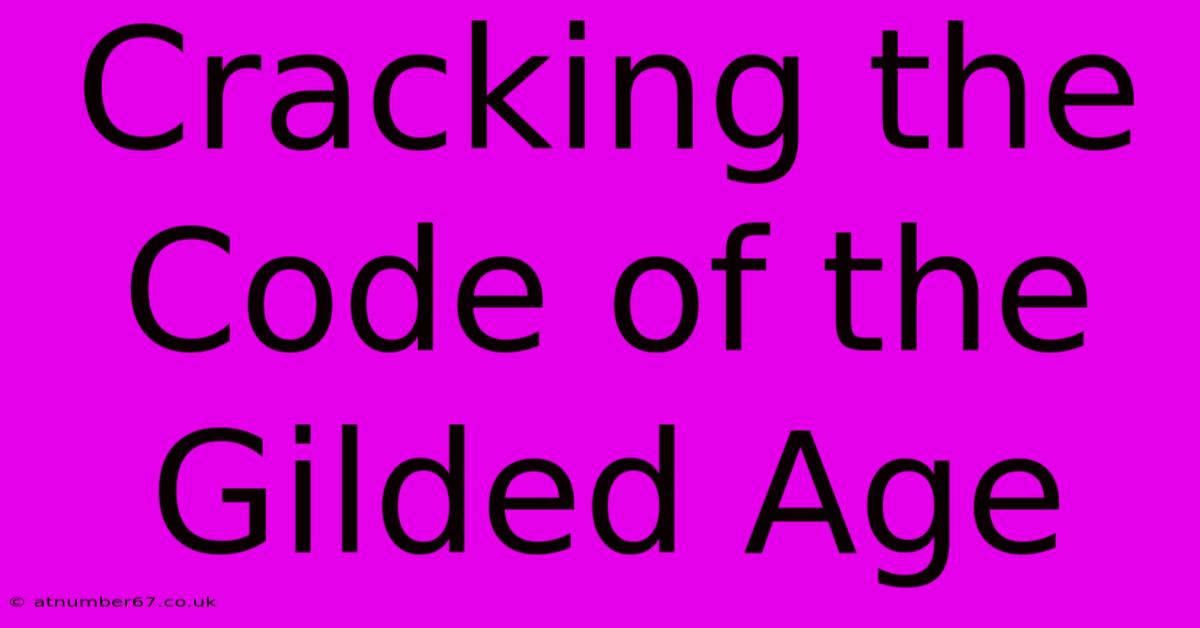Cracking The Code Of The Gilded Age

Table of Contents
Cracking the Code of the Gilded Age: Wealth, Power, and the American Dream
The Gilded Age. The very term conjures images of opulent mansions, robber barons, and a stark contrast between unimaginable wealth and crippling poverty. But beneath the glittering surface of this period in American history (roughly 1870-1900) lies a complex and fascinating story – one of unprecedented industrial growth, social upheaval, and the forging of a modern nation. Understanding this era requires cracking its code, deciphering the interwoven threads of economic transformation, political maneuvering, and social reform.
The Rise of Industrial Titans: More Than Just Money
The Gilded Age witnessed the meteoric rise of industrial titans like Andrew Carnegie (steel), John D. Rockefeller (oil), and J.P. Morgan (finance). These "robber barons," often accused of monopolistic practices and ruthless business tactics, fundamentally reshaped the American economy.
Understanding the Business Strategies:
- Vertical Integration: Carnegie's mastery of vertical integration, controlling every stage of production from raw materials to finished goods, allowed for unparalleled efficiency and cost reduction.
- Horizontal Integration: Rockefeller's strategy of horizontal integration, acquiring competing companies to eliminate competition, created near-monopolies in key industries.
- Consolidation and Trusts: Morgan's expertise in financial consolidation and the formation of trusts further concentrated wealth and power in the hands of a few.
These strategies, while immensely profitable, sparked intense public debate and fueled the rise of populist and progressive movements aiming to curb their power and protect workers' rights.
Political Corruption and the Fight for Reform
The Gilded Age wasn't just about economic power; it was deeply intertwined with political corruption. Powerful industrialists wielded considerable influence over politicians, leading to legislation favorable to their interests and a general disregard for the concerns of ordinary citizens.
The Spoils System and Political Machines:
The spoils system, rewarding political supporters with government jobs, fostered inefficiency and corruption. Powerful political machines, like Tammany Hall in New York City, controlled elections and enriched themselves at the expense of taxpayers.
The Progressive Movement: A Call for Change:
However, the excesses of the Gilded Age also sparked a powerful counter-reaction. The Progressive movement emerged, advocating for reforms like civil service reform, antitrust legislation, and women's suffrage. Figures like Theodore Roosevelt, with his trust-busting initiatives, became symbols of this push for change.
The Social Landscape: Inequality and the American Dream
The stark contrast between the opulent lifestyles of the wealthy and the harsh realities faced by the working class defined the social landscape of the Gilded Age. Rapid industrialization led to overcrowded cities, unsafe working conditions, and widespread poverty.
Immigration and Urbanization:
Massive immigration fueled rapid urbanization, creating both opportunities and challenges. New arrivals faced discrimination and struggled to adapt to a rapidly changing society.
The Rise of Labor Unions:
The harsh conditions faced by workers led to the rise of labor unions, fighting for better wages, shorter hours, and safer working conditions. Events like the Haymarket Riot and the Pullman Strike highlighted the tensions between labor and capital.
Legacy of the Gilded Age: A Foundation for Modern America
Despite its excesses and inequalities, the Gilded Age laid the foundation for much of modern America. Its industrial achievements transformed the nation into a global economic powerhouse, while the social and political struggles of the era spurred significant reforms that continue to shape American society today. Understanding this period is crucial to grasping the complexities of American history and the ongoing debate about the role of wealth, power, and the pursuit of the American Dream.
Keywords: Gilded Age, Robber Barons, Andrew Carnegie, John D. Rockefeller, J.P. Morgan, Industrialization, Progressive Movement, Theodore Roosevelt, Political Corruption, Labor Unions, Immigration, Urbanization, American Dream, Vertical Integration, Horizontal Integration, Trusts, Monopoly, Social Reform.

Thank you for visiting our website wich cover about Cracking The Code Of The Gilded Age. We hope the information provided has been useful to you. Feel free to contact us if you have any questions or need further assistance. See you next time and dont miss to bookmark.
Featured Posts
-
Catriona Grays Age A Timeless Ambassador
Apr 01, 2025
-
The Rise Of Daniel Ricciardo Net Worth And Success
Apr 01, 2025
-
The Secret To Rashmika Mandannas Youthful Looks
Apr 01, 2025
-
Max Verstappens Net Worth Surprising Revelations
Apr 01, 2025
-
Zahide Tiktok Age The Numbers Dont Lie
Apr 01, 2025
